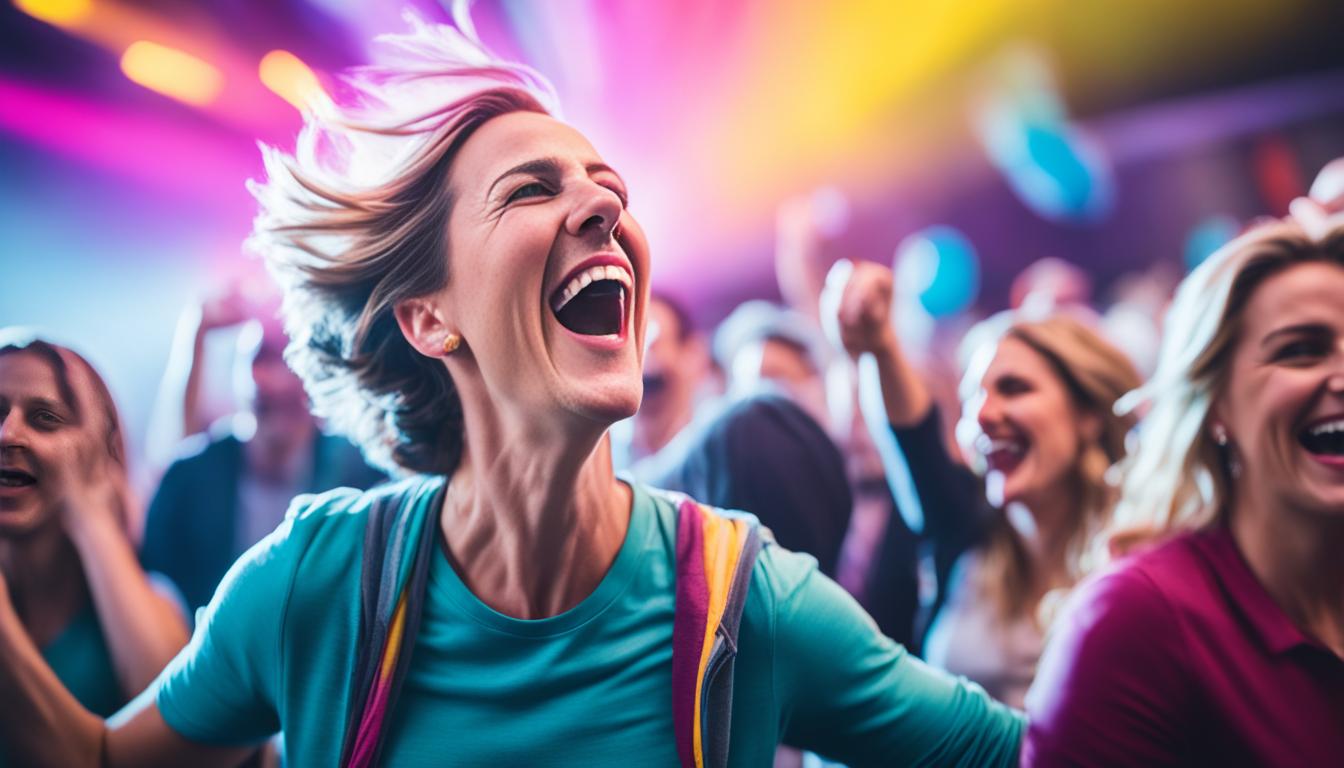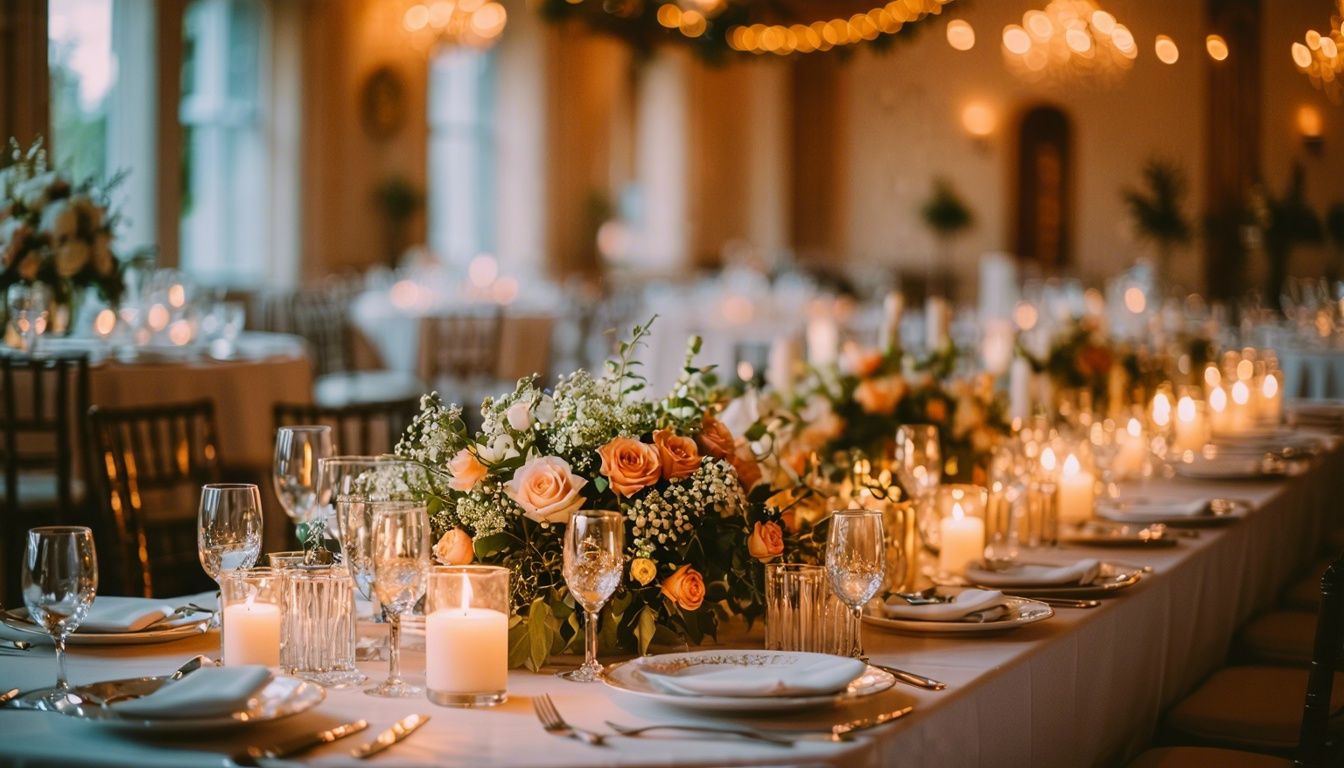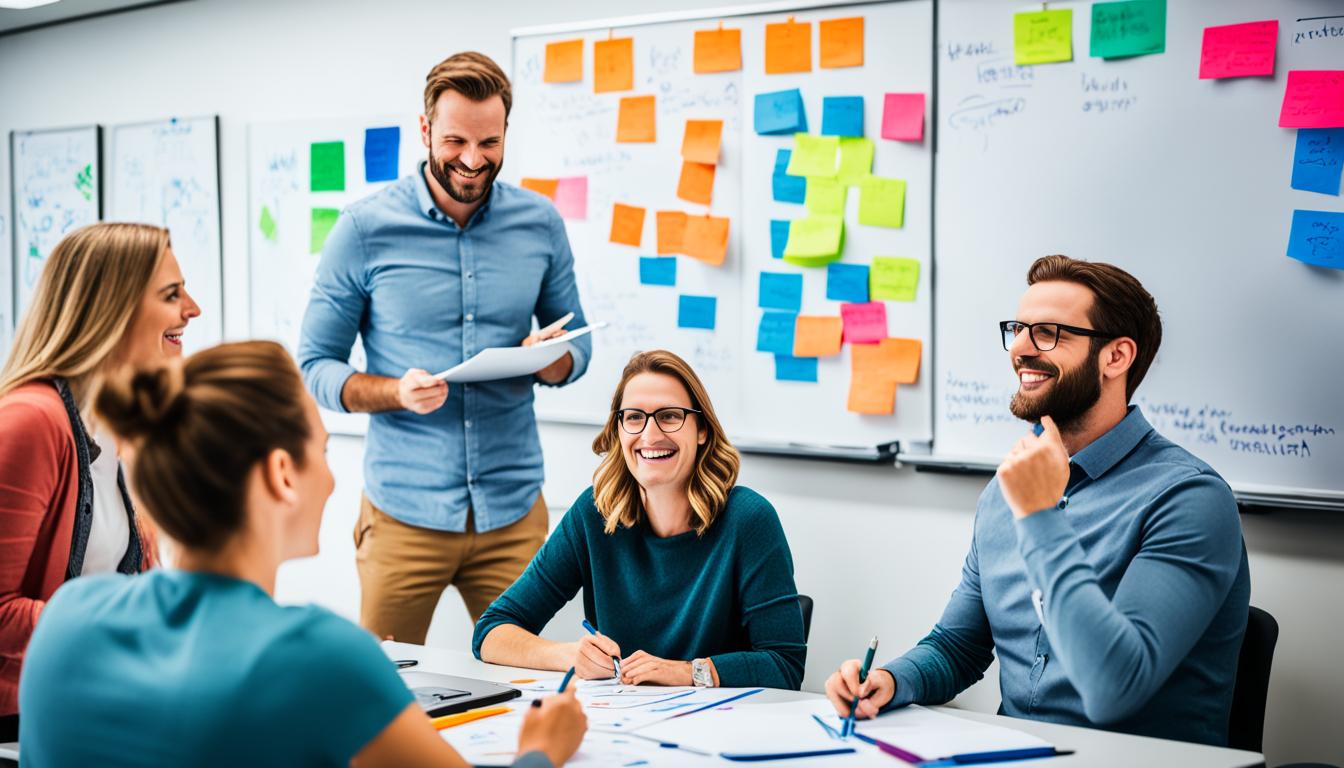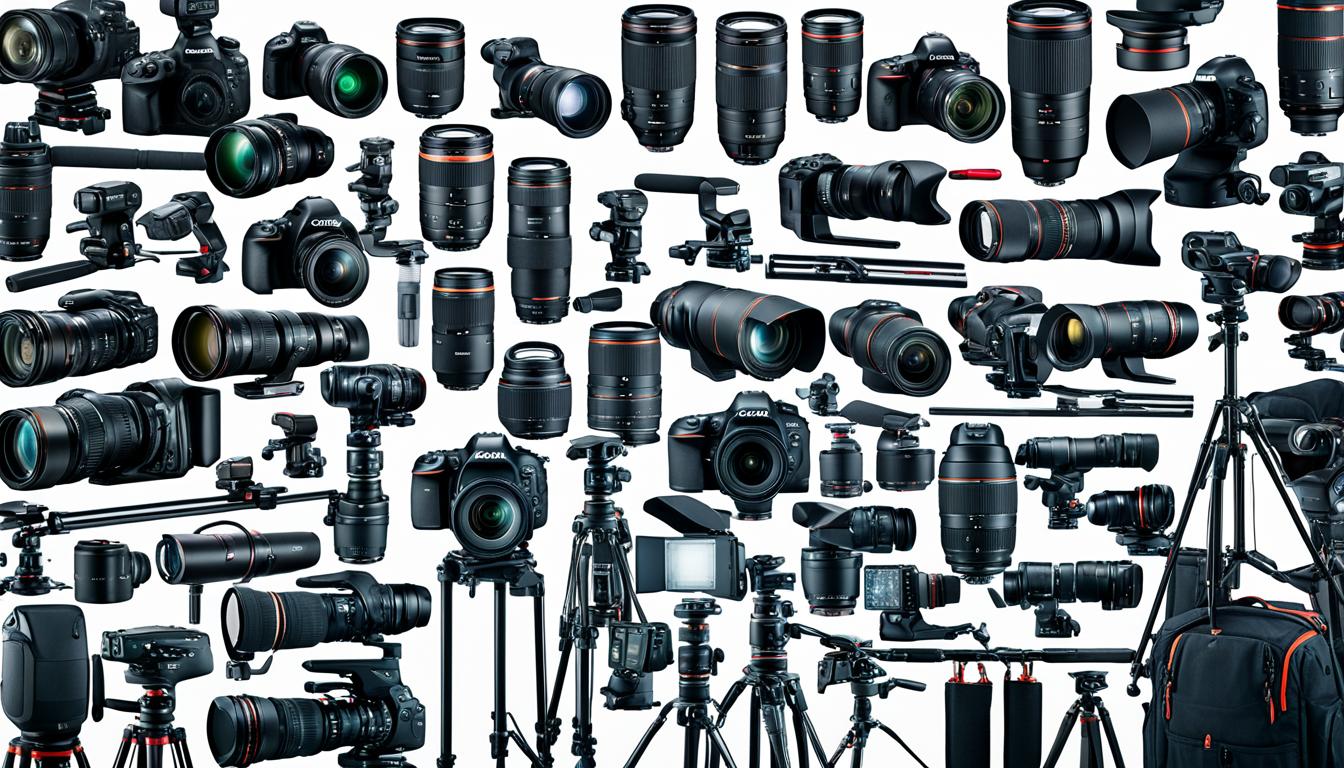Welcome to our guide on mastering event photography and capturing emotion and atmosphere in every shot. As event photographers, we understand the importance of preserving the special moments and unique ambiance of each event, whether it’s a corporate conference, a music festival, or a wedding. Our goal is to tell a story through our images, capturing the raw emotions, candid shots, and the overall essence of the event.
Event photography is more than just taking pictures; it’s an art form that requires specific techniques and a keen eye for detail. By understanding various photography styles and utilizing proper event photography techniques, we create emotive photographs that leave a lasting impression.
To truly master event photography, it’s essential to capture the atmosphere and emotion in a way that transports viewers back to that moment. Through careful composition, lighting techniques, and storytelling, we aim to create images that evoke the same emotions and experiences felt during the event.
Key Takeaways:
- Capturing emotion and atmosphere is crucial in event photography
- Utilize various photography styles and techniques to tell a story through images
- Focus on candid shots and genuine emotions to create emotive photographs
- Pay attention to composition, lighting, and storytelling to transport viewers back to the event
- Mastering event photography requires practice, creativity, and a passion for capturing the essence of each event
Understanding Event Photography Equipment.
Capturing stunning event photos requires the right equipment. As event photographers, we rely on a carefully curated selection of tools to ensure we can capture the desired shots and be prepared for any event. Here are the essential pieces of event photography equipment:
1. Camera
The camera is the heart of an event photographer’s gear. We recommend using a DSLR or mirrorless camera for its versatility, image quality, and ability to handle different lighting conditions.
2. Lenses
A variety of lenses is crucial for capturing different perspectives and compositions. Wide-angle lenses are great for capturing the overall atmosphere and venue, while telephoto lenses allow us to zoom in and capture intimate moments from a distance.
3. Flash
Indoor events or low-light situations often require the use of a flash to ensure well-lit and properly exposed photos. An external flash provides more control over the direction and intensity of the light.
4. Tripod
A tripod is essential for stabilizing the camera and ensuring sharp images, especially in low-light situations or when using longer shutter speeds. It helps us maintain stability and precise framing.
5. Memory Cards and Batteries
Having plenty of memory cards is essential to store the large number of photos taken during an event. We recommend high-capacity and fast memory cards to avoid running out of storage space or missing crucial shots. Additionally, fully charged batteries and backup batteries are a must to prevent any disruptions during the event.
With this essential event photography equipment, we can confidently capture the emotion, atmosphere, and key moments of any event. Being well-prepared ensures that we can deliver exceptional images that our clients will cherish for a lifetime.
Tips for Mastering Event Photography.
Mastering the art of event photography requires more than just having the right equipment. To truly capture the essence of an event and create stunning photographs, there are several key tips to keep in mind.
- Communicate with the Event Organizer: Prior to the event, it is important to establish clear communication with the event organizer. This will help you understand the schedule, key moments, and any specific shots they may want. It is important to clarify expectations and ensure you are prepared to capture all the important aspects of the event.
- Plan Your Shots: Having a well-thought-out shot plan is essential for event photography. This includes identifying important moments you want to capture, such as speeches or performances, as well as considering the overall atmosphere and details. By planning your shots in advance, you can ensure that you don’t miss any crucial moments.
- Capture Candid Moments: While posed shots are important, capturing candid moments adds authenticity and emotion to your photographs. Keep an eye out for natural interactions, laughter, and genuine reactions. These candid moments often tell a compelling story and create a deeper connection with viewers.
- Experiment with Angles: To make your event photos more visually interesting, don’t be afraid to experiment with different angles and perspectives. Try shooting from low angles or unique vantage points to create a fresh and compelling look. This can add a dynamic element to your images and make them stand out.
- Pay Attention to Lighting: Lighting plays a crucial role in event photography. Be aware of the lighting conditions at the venue and adapt accordingly. Use natural light whenever possible, but also be prepared to use flash or other lighting equipment to ensure well-lit photos. Properly managing lighting can greatly enhance the quality of your images.
- Offer Event Photography Packages: To attract more clients and increase revenue, consider offering event photography packages. This can include various options such as different coverage durations, digital images, albums, or prints. Providing packaged options gives clients flexibility and helps differentiate your services from competitors.
Remember, event photography is not just about capturing beautiful images; it’s about telling a story and creating lasting memories. By following these event photography tips, you can elevate your skills and deliver exceptional results for your clients.
Exploring Current Trends in Event Photography.
Event photography is a dynamic field that continually evolves to reflect the latest trends and styles. By staying up-to-date with these trends, photographers can create captivating and innovative images that capture the essence of any event. In this section, we will explore some of the current trends in event photography that are shaping the industry.
Neon Lights in Street Photography
Neon lights have become a popular motif in event photography, particularly in street photography. These vibrant and colorful lights create a visually striking backdrop that adds an electric energy to any captured moment. By incorporating neon lights into their compositions, photographers can infuse their images with a modern and urban aesthetic.
Blurred Motion with Low Shutter Speeds
Another trend in event photography is the use of low shutter speeds to capture blurred motion. This technique adds a sense of dynamism and movement to the images, conveying the energy and excitement of the event. Whether it’s dancers on a stage or a crowd cheering at a concert, capturing motion blur with low shutter speeds creates visually compelling and immersive photographs.
Emphasis on Candid and Unposed Moments
Event photography is moving away from traditional posed shots and embracing candid and unposed moments. By capturing genuine emotions and interactions, photographers can tell authentic stories through their images. Candid shots bring a sense of spontaneity and realism to event photography, making it more relatable and engaging for viewers.
Resurgence of Film Photography
In the digital age, film photography is experiencing a resurgence in popularity. The unique look and nostalgic feel of film have captivated photographers and clients alike. Shooting events on film adds a timeless quality to the images, evoking a sense of warmth and sentimentality. Film photography often emphasizes rich colors, grain, and subtle imperfections that create a distinct aesthetic.
Simplicity and Minimalism
The trend towards simplicity and minimalism in event photography focuses on clean compositions and uncluttered backgrounds. By eliminating distractions, photographers can draw attention to the subject and the emotions being captured. Minimalist event photography highlights the beauty in simplicity and allows the viewer to fully immerse themselves in the moment.
Inclusive Representation and Age Diversity
Event photography is embracing inclusivity and age diversity, reflecting the diverse attendees at various events. Celebrating people of all ages, backgrounds, and cultures has become a significant trend in the industry. By showcasing the diversity of event participants, photographers capture the essence of the event’s vibrant and inclusive atmosphere.
Rise of Aerial Photography with Drones
Aerial photography has seen a rise in popularity with the advent of drones. This trend allows photographers to capture unique perspectives and stunning aerial views of events. Drones provide a bird’s-eye view that was once inaccessible, adding a sense of grandeur and scale to event photography. Aerial images captured by drones are visually stunning and offer a fresh and captivating angle.
Popularity of Virtual Photo Booths
Virtual photo booths have become increasingly popular at events, offering a unique and interactive experience for attendees. These booths allow users to take selfies and create personalized digital souvenirs. With customizable backgrounds and augmented reality filters, virtual photo booths provide a fun and engaging element to events, making them memorable for both guests and hosts.
AI-Enhanced and Personalized Photography
The integration of artificial intelligence (AI) in event photography has revolutionized the industry. AI-powered cameras can analyze and enhance images in real-time, ensuring optimal exposure, focus, and composition. Additionally, AI algorithms can personalize the photography experience by automatically recognizing individuals and applying customized filters or effects. This technology enables photographers to deliver high-quality and tailored images to their clients.
Y2K Aesthetic in Photography
The Y2K (Year 2000) aesthetic has made a resurgence in event photography, adding a nostalgic and retro vibe to images. Inspired by the turn of the millennium, this aesthetic incorporates vibrant colors, futuristic elements, and digital glitches. By embracing the Y2K aesthetic, photographers can create visually captivating images that transport viewers back in time and evoke a sense of nostalgia.
Stay ahead of the curve by integrating these current trends into your event photography. Whether it’s capturing the neon-lit streets, embracing candid moments, or utilizing drone technology, these trends offer exciting opportunities to push the boundaries and create truly remarkable images.

Essential Equipment for Event Photography.
When it comes to event photography, having the right equipment is essential for capturing the best shots. Whether you’re photographing a wedding, a corporate event, or a music festival, having the right gear ensures that you’re prepared to capture memorable moments.
Here are some of the essential equipment items for event photography:
- Camera: It is important to invest in a high-quality camera for event photography. Both DSLR and mirrorless cameras are popular choices, offering versatility and excellent image quality.
- Lenses: A variety of lenses allows you to capture different perspectives and compositions. Wide-angle lenses are great for capturing the entire scene, while telephoto lenses help you get close-up shots from a distance.
- External Flash: In indoor or low-light situations, an external flash is crucial for properly illuminating the subject and capturing well-exposed photos.
- Tripod or Monopod: To ensure stability and sharpness in your photos, a tripod or monopod can be extremely helpful, especially when shooting in low-light conditions or using longer shutter speeds.
- Memory Cards and Backup Solutions: Events can last for several hours, and you’ll want to have plenty of memory cards to store all your photos. Additionally, having a backup solution, such as an external hard drive or cloud storage, is essential to protect your images.
- Additional Accessories: There are various additional accessories that can enhance your event photography, such as gels or diffusers for your flash to modify the lighting, extra batteries to ensure you don’t run out of power during a long event, and a remote shutter release for capturing self-portraits or group shots.
Investing in the right equipment not only allows you to capture high-quality photos but also gives you the confidence to tackle any event photography challenge that comes your way.
Take a look at the table below for a visual summary of the essential equipment for event photography:
| Equipment | Description |
|---|---|
| Camera | DSLR or Mirrorless |
| Lenses | Wide-angle, Telephoto |
| External Flash | For indoor or low-light situations |
| Tripod or Monopod | For stability and sharpness |
| Memory Cards and Backup Solutions | Plenty of storage and data security |
| Additional Accessories | Gels, Diffusers, Extra Batteries, Remote Shutter Release |
Having the right equipment sets you up for success in event photography, allowing you to capture stunning images that tell the story of the event. With the right gear in your arsenal, you’ll be ready to capture memorable moments that clients and event attendees will cherish.
Getting Started in Event Photography.
Embarking on a career in event photography is an exciting opportunity to capture captivating moments and immortalize the atmosphere and emotions of important gatherings. Whether you aspire to document corporate events, weddings, music festivals, or trade shows, there are a few essential steps you can take to get started in this exhilarating field.
Building a Portfolio
An impressive portfolio is the key to showcasing your skills and attracting potential clients. Start by photographing events for friends and family, offering your services free of charge in exchange for the opportunity to capture meaningful memories. Additionally, consider volunteering your photography skills for local organizations or community events. This will not only allow you to practice your craft but also provide you with a diverse range of event photography samples to showcase in your portfolio.
Networking
Networking is an essential aspect of establishing your presence as an event photographer. Attend industry events, such as photography conferences or trade shows, where you can connect with fellow professionals. Join local photography groups or associations to expand your network and gain valuable insights from experienced photographers. By actively engaging in networking opportunities, you can form connections with potential clients and establish your reputation in the industry.
Continuous Learning and Improvement
The field of event photography is constantly evolving, and it’s important to stay up-to-date with the latest trends, techniques, and technological advancements. Attend workshops, take online courses, and participate in photography forums to continuously enhance your skills. By immersing yourself in a community of fellow photographers, you can gain valuable insights, receive constructive feedback, and exchange ideas. Embracing a mindset of continuous learning and improvement will ensure that you stay competitive in the dynamic world of event photography.
“Success in event photography is built upon a strong portfolio, a wide network of connections, and a commitment to continuous learning. These elements form the foundation for a thriving career capturing memorable moments at events.”

With dedication, persistence, and a passion for storytelling through images, you can excel in the art of event photography. Continuously build your portfolio, expand your network, and seek opportunities for growth. By perfecting your craft and staying attuned to the latest industry trends, you can capture the essence of every event, preserving unforgettable memories for your clients.
Capturing Emotion and Atmosphere in Event Photography – Real Examples.
Event photography encompasses a wide range of events, each with its own unique atmosphere and emotions. Let’s explore some real-world examples that showcase the artistry of capturing emotion and atmosphere in different types of events.
Corporate Events
Corporate events require photographers to capture the ambiance and showcase the event to potential attendees and sponsors. From formal conferences to lively networking events, corporate event photography aims to highlight the professionalism and energy of these gatherings.
Trade Shows
Trade shows provide photographers with the opportunity to capture compelling photos of booths, commercial exhibits, and the interactions between vendors and attendees. These images are crucial in conveying the excitement and innovation that trade shows offer.
Music Festivals
Music festivals are known for their vibrant energy and electrifying performances. Event photographers at music festivals aim to capture the spirit of the event, from the exhilarating stage acts to the enthusiastic crowds. These photos transport viewers into the heart of the festival experience.
Weddings
Weddings are one of the most popular forms of event photography, requiring photographers to capture the emotional moments and special details of this joyous celebration. From the tears of joy during the ceremony to the laughter and heartfelt speeches at the reception, wedding photographers have the privilege of documenting love and happiness.
Real-world examples of event photography demonstrate the diversity and artistry of capturing emotion and atmosphere in different events. From the elegant setting of a corporate event to the dynamic energy of a music festival, these photographs preserve the memories and essence of each event, allowing viewers to relive the experience and feel the emotions that were present.
Conclusion.
Event photography is an exciting and dynamic field that requires technical skills, creativity, and the ability to work in a fast-paced environment. By following tips, using the right equipment, staying updated with trends, and continuously improving, photographers can excel in capturing the emotion and atmosphere of events.
Event photography allows people to relive and share their experiences while providing valuable marketing materials for event organizers. The ability to capture the essence of an event through emotive photographs is invaluable in today’s digital age.
Mastering the art of event photography requires practice, dedication, and a passion for storytelling through images. It’s about going beyond capturing mere moments, but rather creating visual narratives that transport viewers back to the event. With each click of the shutter, event photographers have the power to freeze time and evoke emotions.
Whether it’s a corporate conference, a music festival, or a wedding, event photography brings people together and immortalizes the magic of these occasions. So, if you have a love for photography and a desire to capture the heart and soul of events, event photography may be the perfect path for you.
FAQ
What is event photography?
Event photography is the art of capturing the essence of an event and creating unforgettable memories through photographs. It involves documenting the atmosphere, emotions, and key moments of various types of events, such as corporate conferences, weddings, and music festivals.
What equipment do I need for event photography?
Essential equipment for event photography includes a camera (preferably a DSLR or mirrorless), a variety of lenses (wide-angle and telephoto), a flash for indoor or low-light situations, a tripod for stability, plenty of memory cards, and fully charged batteries.
How can I master event photography?
To master event photography, it is important to communicate with the event organizer, get a detailed schedule, and plan shots accordingly. While posed shots are important, capturing candid moments adds authenticity and emotion to photos. Experimenting with different angles, paying attention to lighting, and offering event photography packages can also enhance your skills.
What are the current trends in event photography?
Current trends in event photography include the use of neon lights in street photography, capturing blurred motion with low shutter speeds, focusing on candid and unposed moments, resurgence of film photography, simplicity and minimalism, inclusive representation and age diversity, aerial photography with drones, popularity of virtual photo booths and AI-enhanced photography, and the Y2K aesthetic.
What equipment is essential for event photography?
Essential equipment for event photography includes a DSLR or mirrorless camera, a variety of lenses, an external flash, a tripod or monopod, plenty of memory cards, and additional accessories like gels or diffusers for flash lighting.
How can I get started in event photography?
To get started in event photography, build a strong portfolio by photographing events for friends and family or volunteering for local organizations. Network with others in the industry by attending events and joining photography groups. Continuous learning through workshops, online courses, and staying updated with the latest trends and techniques is also essential.
Can you provide examples of event photography?
Event photography examples include capturing the ambiance and showcasing corporate events, compelling photographs of booths and exhibits at trade shows, capturing the energy and excitement of music festivals, and documenting the emotional moments and special details of weddings.
Why is event photography important?
Event photography is important as it serves as a marketing tool for event organizers, allowing them to showcase their events to potential attendees and sponsors. It also provides attendees with a way to relive and share their experiences, creating lasting memories.
How Can I Apply Mood and Atmosphere Techniques in Event Photography?
When it comes to event photography, crafting mood and atmosphere techniques is pivotal. Play with lighting, angles, and composition to evoke the desired emotions. Utilize natural light to create a warm and inviting atmosphere, or use shadows for a more dramatic effect. Experiment with different techniques to capture the essence of the event.




